publications
List of publications in a reversed chronological order
2025
-
 Programmable Magnetic Hysteresis in Orthogonally-Twisted 2D CrSBr Magnets via Stacking EngineeringCarla Boix-Constant, Andrey Rybakov, Clara Miranda-Pérez, Gabriel Martínez-Carracedo, Jaime Ferrer, Samuel Mañas-Valero, and Eugenio CoronadoAdvanced Materials, 2025
Programmable Magnetic Hysteresis in Orthogonally-Twisted 2D CrSBr Magnets via Stacking EngineeringCarla Boix-Constant, Andrey Rybakov, Clara Miranda-Pérez, Gabriel Martínez-Carracedo, Jaime Ferrer, Samuel Mañas-Valero, and Eugenio CoronadoAdvanced Materials, 2025Twisting 2D van der Waals magnets allows the formation and control of different spin-textures, as skyrmions or magnetic domains. Beyond the rotation angle, different spin reversal processes can be engineered by increasing the number of magnetic layers forming the twisted van der Waals heterostructure. Here, pristine monolayers and bilayers of the A-type antiferromagnet CrSBr are considered as building blocks. By rotating 90 degrees these units, symmetric (monolayer/monolayer and bilayer/bilayer) and asymmetric (monolayer/bilayer) heterostructures are fabricated. The magneto-transport properties reveal the appearance of magnetic hysteresis, which is highly dependent upon the magnitude and direction of the applied magnetic field and is determined not only by the twist-angle but also by the number of layers forming the stack. This high tunability allows switching between volatile and non-volatile magnetic memory at zero-field and controlling the appearance of abrupt magnetic reversal processes at either negative or positive field values on demand. The phenomenology is rationalized based on the different spin-switching processes occurring in the layers, as supported by micromagnetic simulations. The results highlight the combination between twist-angle and number of layers as key elements for engineering spin-switching reversals in twisted magnets, of interest toward the miniaturization of spintronic devices and realizing novel spin textures.
@article{boix2025programmable, title = {Programmable Magnetic Hysteresis in Orthogonally-Twisted 2D CrSBr Magnets via Stacking Engineering}, author = {Boix-Constant, Carla and Rybakov, Andrey and Miranda-Pérez, Clara and Martínez-Carracedo, Gabriel and Ferrer, Jaime and Mañas-Valero, Samuel and Coronado, Eugenio}, journal = {Advanced Materials}, issn = {1521-4095}, volume = {}, number = {}, pages = {}, year = {2025}, publisher = {Wiley}, doi = {10.1002/adma.202415774}, url = {http://dx.doi.org/10.1002/adma.202415774}, } -
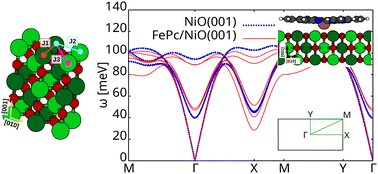 Chemical tuning of magnons in NiO(001) by Fe-phthalocyanine adsorptionMarco Marino, Gonzalo Rivero-Carracedo, Andrey Rybakov, José J. Baldoví, and Guido FratesiPhysical Chemistry Chemical Physics, 2025
Chemical tuning of magnons in NiO(001) by Fe-phthalocyanine adsorptionMarco Marino, Gonzalo Rivero-Carracedo, Andrey Rybakov, José J. Baldoví, and Guido FratesiPhysical Chemistry Chemical Physics, 2025Magnonics is a rapidly growing field that is nowadays broadly recognized as a paradigm shift for information and communication technologies. In this context, antiferromagnetic materials are particularly relevant due to the lack of stray fields and their faster dynamics, with frequencies in the THz range and longer spin relaxation times. Herein, we investigate the chemical tuning of magnons in a prototypical antiferromagnetic transition metal oxide through the creation of a hybrid heterostructure formed by an Fe-phthalocyanine layer over a NiO(001) substrate. Our first-principles calculations for the hybrid material allow us to evaluate the effect of the adsorbed molecules on the electronic structure, charge transfer and magnetic exchange couplings of NiO. In particular, we observe an electron density flow from the O towards the Ni atoms in the substrate, and from the O atoms towards the molecule at the interface. As a result, the magnetic couplings are enhanced by 7.7% at the surface, accompanied by a decrease by 19.1% in the layer below the surface. Interestingly, our results predict a shift of the magnon frequencies by 10 meV in the optical branch. This work provides a new step towards the design of molecular controlled magnetic materials for magnonic applications.
@article{marino2025chemical, title = {Chemical tuning of magnons in NiO(001) by Fe-phthalocyanine adsorption}, author = {Marino, Marco and Rivero-Carracedo, Gonzalo and Rybakov, Andrey and Baldoví, José J. and Fratesi, Guido}, journal = {Physical Chemistry Chemical Physics}, issn = {1463-9084}, volume = {27}, number = {12}, pages = {6249-6254}, year = {2025}, publisher = {Royal Society of Chemistry (RSC)}, doi = {10.1039/d4cp04547e}, url = {https://doi.org/10.1039/D4CP04547E}, }
2024
-
 Towards molecular controlled magnonicsAlberto M Ruiz, Gonzalo Rivero-Carracedo, Andrey Rybakov, Sourav Dey, and José J Baldovı́Nanoscale Advances, 2024
Towards molecular controlled magnonicsAlberto M Ruiz, Gonzalo Rivero-Carracedo, Andrey Rybakov, Sourav Dey, and José J Baldovı́Nanoscale Advances, 2024Magnonics is an emerging field broadly recognized as a paradigm shift for information technologies based on the use of spin waves. However, the low flexibility and variety of the existing systems still hamper their applications. Herein, we propose an unprecedented chemical approach to magnonics based on the creation of hybrid molecular/2D heterostructures. We analyse the modulation of the magnetic properties, magnon dispersion and spin dynamics of a single layer of CrSBr after the deposition of sublimable organic molecules via first-principles calculations. Our results predict a modulation of magnetic exchange, a shift in the magnon frequencies and an enhancement of their group velocities up to 7%. Interestingly, we find a linear correlation between these effects and the donor character of the molecules. This will pave the way for the design of a new class of magnonic materials that can be selectively tailored by a chemical approach.
@article{ruiz2024towards, title = {Towards molecular controlled magnonics}, author = {Ruiz, Alberto M and Rivero-Carracedo, Gonzalo and Rybakov, Andrey and Dey, Sourav and Baldov{\'\i}, Jos{\'e} J}, journal = {Nanoscale Advances}, volume = {6}, number = {13}, pages = {3320-3328}, year = {2024}, publisher = {Royal Society of Chemistry (RSC)}, doi = {10.1039/d4na00230j}, url = {https://pubs.rsc.org/en/content/articlelanding/2024/na/d4na00230j}, } - Magnon Sensing of NO, NO2 and NH3 Gas Capture on CrSBr MonolayerGonzalo Rivero-Carracedo, Andrey Rybakov, and José J Baldovı́Chemistry - A European Journal, 2024
Air pollution and greenhouse emissions are significant problems across various sectors, urging the need for advanced technologies to detect and capture harmful gases. In recent years, two-dimensional (2D) materials have attracted increasing attention due to their large surface-to-volume ratio and reactivity. Herein, we investigate the potential of single-layer CrSBr for gas sensing and capturing by means of first-principles calculations. We explore the adsorption behaviour of different pollutant gases (H2S, NH3, NO, NO2, CO and CO2) on this 2D ferromagnet and the impact of intrinsic defects on its magnetic properties. Interestingly, we find that Br vacancies enhance the adsorption of NH3, NO and NO2 and induce a selective frequency shift on the magnon dispersion. This work motivates the creation of novel magnonic gas sensing devices based on 2D van der Waals magnetic materials.
@article{riverocarracedo2024magnon, title = {Magnon Sensing of NO, NO2 and NH3 Gas Capture on CrSBr Monolayer}, author = {Rivero-Carracedo, Gonzalo and Rybakov, Andrey and Baldov{\'\i}, Jos{\'e} J}, journal = {Chemistry - A European Journal}, volume = {}, number = {}, pages = {}, year = {2024}, publisher = {Wiley}, doi = {10.1002/chem.202401092}, url = {https://chemistry-europe.onlinelibrary.wiley.com/doi/abs/10.1002/chem.202401092}, } -
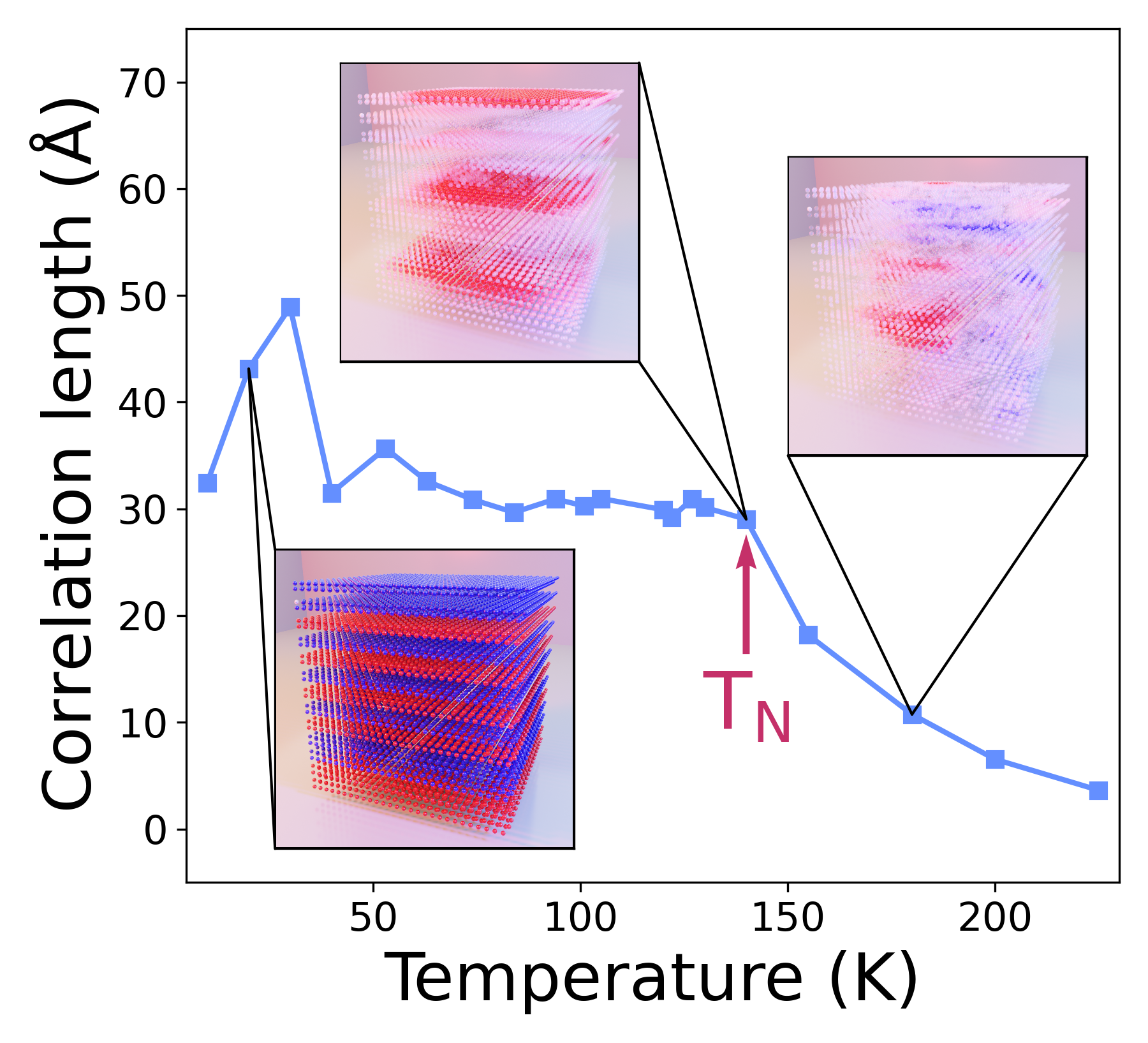 Probing Short-Range Correlations in the van der Waals Magnet CrSBr by Small-Angle Neutron ScatteringAndrey Rybakov, Carla Boix-Constant, Diego Alba Venero, Herre S. J. Zant, Samuel Mañas-Valero, and Eugenio CoronadoSmall Science, 2024
Probing Short-Range Correlations in the van der Waals Magnet CrSBr by Small-Angle Neutron ScatteringAndrey Rybakov, Carla Boix-Constant, Diego Alba Venero, Herre S. J. Zant, Samuel Mañas-Valero, and Eugenio CoronadoSmall Science, 2024The layered metamagnet CrSBr offers a rich interplay between magnetic, optical, and electrical properties that can be extended down to the two-dimensional (2D) limit. Despite the extensive research regarding the long-range magnetic order in magnetic van der Waals materials, short-range correlations have been loosely investigated. By using small-angle neutron scattering (SANS) the formation of short-range magnetic regions in CrSBr with correlation lengths that increase upon cooling up to ≈3 nm at the antiferromagnetic ordering temperature (T_N ≈ 140 K) is shown. Interestingly, these ferromagnetic correlations start developing below 200 K, i.e., well above T N. Below T N, these correlations rapidly decrease and are negligible at low-temperatures. The experimental results are well-reproduced by an effective spin Hamiltonian, which pinpoints that the short-range correlations in CrSBr are intrinsic to the monolayer limit, and discard the appearance of any frustrated phase in CrSBr at low-temperatures within the experimental window between 2 and 200 nm. Overall, the obtained results are compatible with a spin freezing scenario of the magnetic fluctuations in CrSBr and highlight SANS as a powerful technique for characterizing the rich physical phenomenology beyond the long-range order paradigm offered by van der Waals magnets.
@article{rybakov2024probing, title = {Probing Short-Range Correlations in the van der Waals Magnet CrSBr by Small-Angle Neutron Scattering}, author = {Rybakov, Andrey and Boix-Constant, Carla and Alba Venero, Diego and van der Zant, Herre S. J. and Mañas-Valero, Samuel and Coronado, Eugenio}, journal = {Small Science}, volume = {}, number = {}, pages = {}, year = {2024}, publisher = {Wiley}, doi = {doi.org/10.1002/smsc.202400244}, url = {https://onlinelibrary.wiley.com/doi/full/10.1002/smsc.202400244}, }
2022
-
 Tailoring spin waves in 2D transition metal phosphorus trichalcogenides via atomic-layer substitutionAlberto M Ruiz, Dorye L Esteras, Andrey Rybakov, and José J Baldovı́Dalton Transactions, 2022
Tailoring spin waves in 2D transition metal phosphorus trichalcogenides via atomic-layer substitutionAlberto M Ruiz, Dorye L Esteras, Andrey Rybakov, and José J Baldovı́Dalton Transactions, 2022The family of two-dimensional (2D) van der Waals transition metal phosphorus trichalcogenides has received renewed interest due to their intrinsic 2D antiferromagnetism, which proves them as unprecedented and highly tunable building blocks for spintronics and magnonics at the single-layer limit. Herein, motivated by the exciting potential of atomic-substitution demonstrated by Janus transition metal dichalcogenides, we investigated the crystal, electronic and magnetic structures of selenized Janus monolayers based on MnPS3 and NiPS3 from first-principles. In addition, we calculated the magnon dispersion and performed real-time real-space atomistic dynamic simulations to explore the propagation of spin waves in MnPS3, NiPS3, MnPS1.5Se1.5 and NiPS1.5Se1.5. Our calculations predict a drastic enhancement of magnetic anisotropy and the emergence of large Dzyaloshinskii-Moriya interactions, which arise from the induced broken inversion symmetry in the 2D Janus layers. These results pave the way for the development of Janus 2D transition metal phosphorus trichalcogenides and highlight their potential for magnonic applications.
@article{ruiz2022tailoring, title = {Tailoring spin waves in 2D transition metal phosphorus trichalcogenides via atomic-layer substitution}, author = {Ruiz, Alberto M and Esteras, Dorye L and Rybakov, Andrey and Baldov{\'\i}, Jos{\'e} J}, journal = {Dalton Transactions}, volume = {51}, number = {44}, pages = {16816--16823}, year = {2022}, publisher = {Royal Society of Chemistry}, doi = {10.1039/D2DT02482A}, url = {https://pubs.rsc.org/en/content/articlelanding/2022/DT/D2DT02482A}, } -
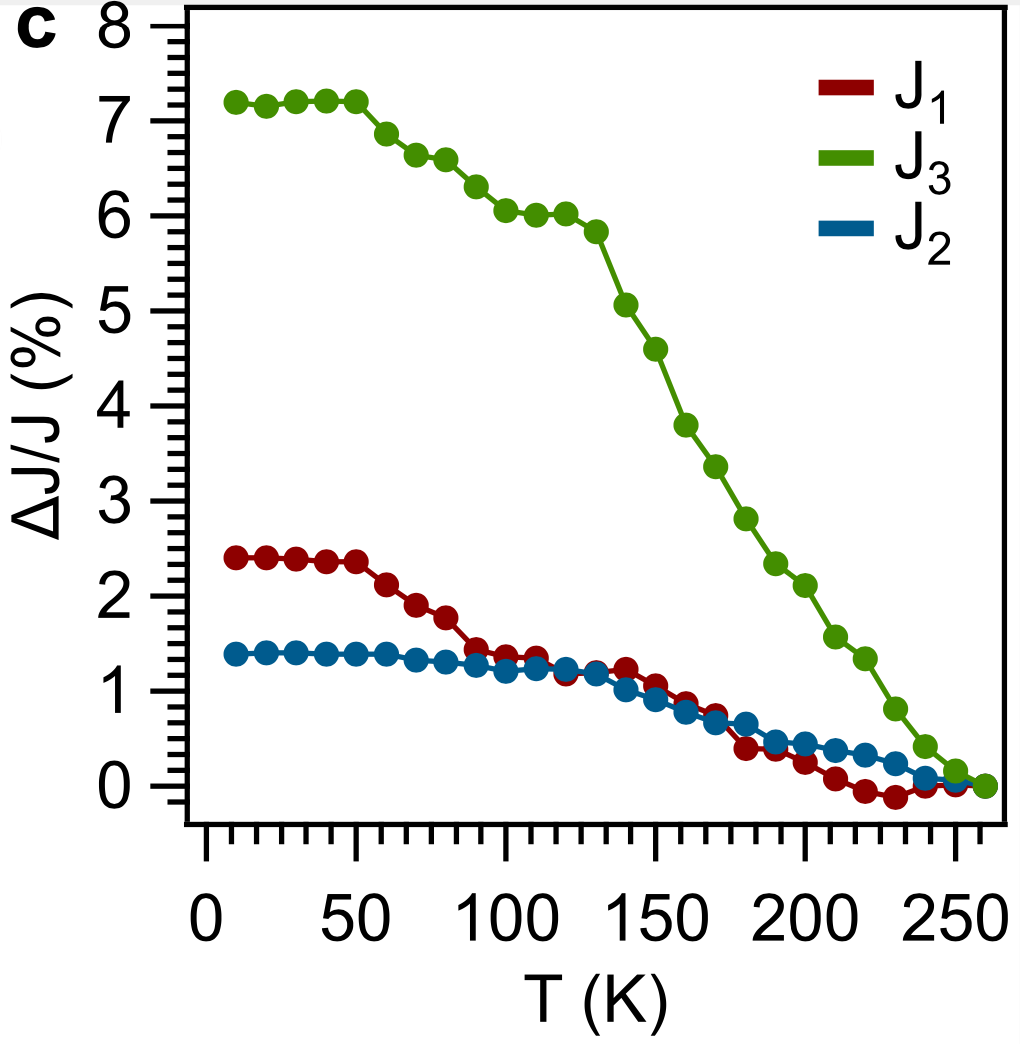 Probing the Spin Dimensionality in Single-Layer CrSBr Van Der Waals Heterostructures by Magneto-Transport MeasurementsCarla Boix-Constant, Samuel Mañas-Valero, Alberto M Ruiz, Andrey Rybakov, Krzysztof Aleksander Konieczny, Sébastien Pillet, José J Baldovı́, and Eugenio CoronadoAdvanced Materials, 2022
Probing the Spin Dimensionality in Single-Layer CrSBr Van Der Waals Heterostructures by Magneto-Transport MeasurementsCarla Boix-Constant, Samuel Mañas-Valero, Alberto M Ruiz, Andrey Rybakov, Krzysztof Aleksander Konieczny, Sébastien Pillet, José J Baldovı́, and Eugenio CoronadoAdvanced Materials, 20222D magnetic materials offer unprecedented opportunities for fundamental and applied research in spintronics and magnonics. Beyond the pioneering studies on 2D CrI3 and Cr2Ge2Te6, the field has expanded to 2D antiferromagnets exhibiting different spin anisotropies and textures. Of particular interest is the layered metamagnet CrSBr, a relatively air-stable semiconductor formed by antiferromagnetically-coupled ferromagnetic layers (Tc 150 K) that can be exfoliated down to the single-layer. It presents a complex magnetic behavior with a dynamic magnetic crossover, exhibiting a low-temperature hidden-order below T* 40 K. Here, the magneto-transport properties of CrSBr vertical heterostructures in the 2D limit are inspected. The results demonstrate the marked low-dimensional character of the ferromagnetic monolayer, with short-range correlations above Tc and an Ising-type in-plane anisotropy, being the spins spontaneously aligned along the easy axis b below Tc. By applying moderate magnetic fields along a and c axes, a spin-reorientation occurs, leading to a magnetoresistance enhancement below T*. In multilayers, a spin-valve behavior is observed, with negative magnetoresistance strongly enhanced along the three directions below T*. These results show that CrSBr monolayer/bilayer provides an ideal platform for studying and controlling field-induced phenomena in two-dimensions, offering new insights regarding 2D magnets and their integration into vertical spintronic devices.
@article{boix2022probing, title = {Probing the Spin Dimensionality in Single-Layer CrSBr Van Der Waals Heterostructures by Magneto-Transport Measurements}, author = {Boix-Constant, Carla and Ma{\~n}as-Valero, Samuel and Ruiz, Alberto M and Rybakov, Andrey and Konieczny, Krzysztof Aleksander and Pillet, S{\'e}bastien and Baldov{\'\i}, Jos{\'e} J and Coronado, Eugenio}, journal = {Advanced Materials}, volume = {34}, number = {41}, pages = {2204940}, year = {2022}, publisher = {Wiley Online Library}, doi = {10.1002/adma.202204940}, url = {https://onlinelibrary.wiley.com/doi/full/10.1002/adma.202204940}, } -
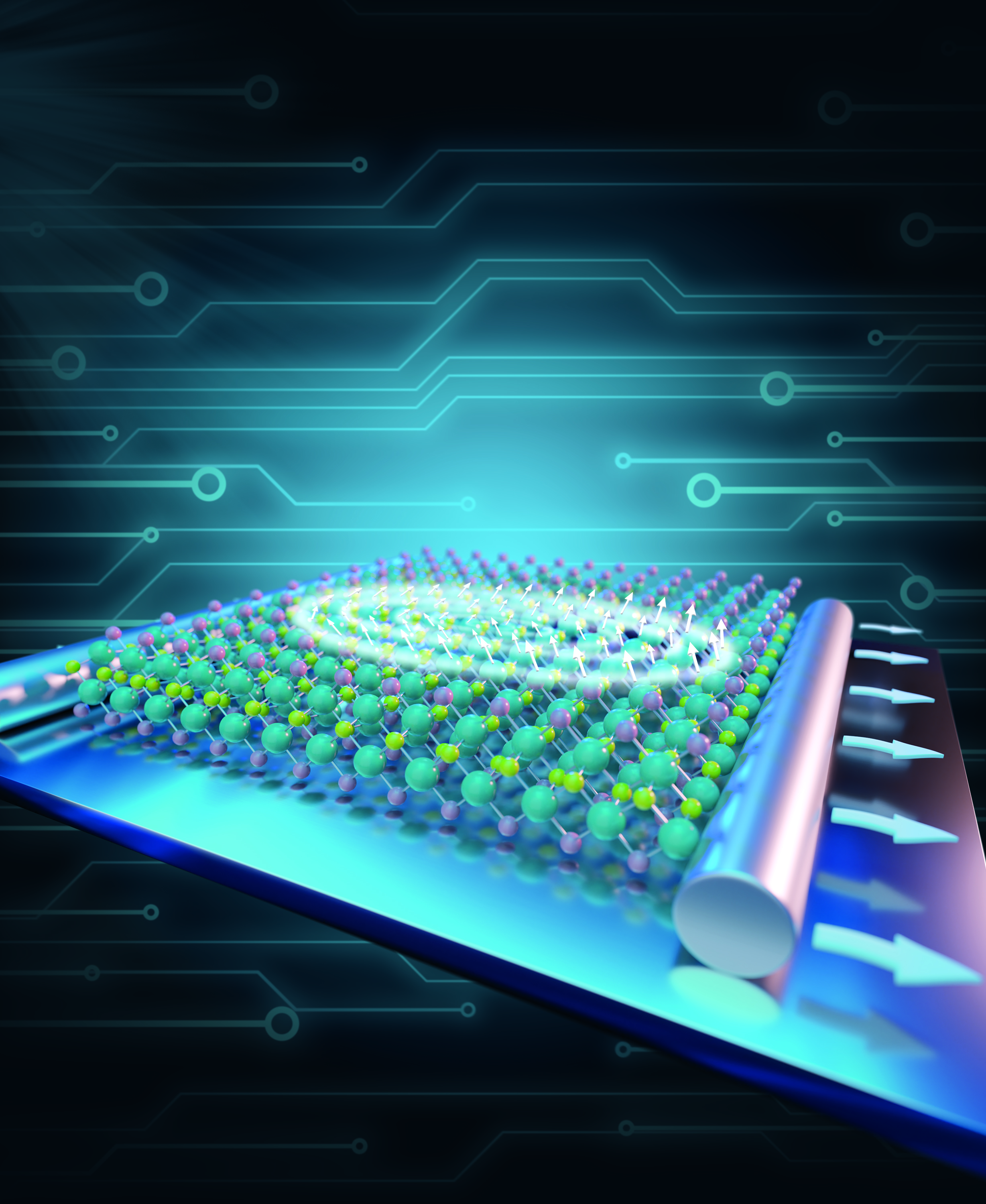 Magnon straintronics in the 2D van der Waals ferromagnet CrSBr from first-principlesDorye L Esteras, Andrey Rybakov, Alberto M Ruiz, and José J Baldovı́Nano Letters, 2022
Magnon straintronics in the 2D van der Waals ferromagnet CrSBr from first-principlesDorye L Esteras, Andrey Rybakov, Alberto M Ruiz, and José J Baldovı́Nano Letters, 2022The recent isolation of two-dimensional (2D) magnets offers tantalizing opportunities for spintronics and magnonics at the limit of miniaturization. One of the key advantages of atomically thin materials is their outstanding deformation capacity, which provides an exciting avenue to control their properties by strain engineering. Herein, we investigate the magnetic properties, magnon dispersion, and spin dynamics of the air-stable 2D magnetic semiconductor CrSBr (TC=146 K) under mechanical strain using first-principles calculations. Our results provide a deep microscopic analysis of the competing interactions that stabilize the long-range ferromagnetic order in the monolayer. We showcase that the magnon dynamics of CrSBr can be modified selectively along the two main crystallographic directions as a function of applied strain, probing the potential of this quasi-1D electronic system for magnon straintronics applications. Moreover, we predict a strain-driven enhancement of TC by 30%, allowing the propagation of spin waves at higher temperatures.
@article{esteras2022magnon, title = {Magnon straintronics in the 2D van der Waals ferromagnet CrSBr from first-principles}, author = {Esteras, Dorye L and Rybakov, Andrey and Ruiz, Alberto M and Baldov{\'\i}, Jos{\'e} J}, journal = {Nano Letters}, volume = {22}, number = {21}, pages = {8771--8778}, year = {2022}, publisher = {ACS Publications}, doi = {10.1021/acs.nanolett.2c02863}, url = {https://pubs.acs.org/doi/full/10.1021/acs.nanolett.2c02863}, }
2021
-
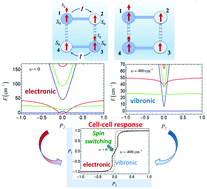 Toward multifunctional molecular cells for quantum cellular automata: exploitation of interconnected charge and spin degrees of freedomPhysical Chemistry Chemical Physics, 2021
Toward multifunctional molecular cells for quantum cellular automata: exploitation of interconnected charge and spin degrees of freedomPhysical Chemistry Chemical Physics, 2021We discuss the possibility of using mixed-valence (MV) dimers comprising paramagnetic metal ions as molecular cells for quantum cellular automata (QCA). Thus, we propose to combine the underlying idea behind the functionality of QCA of using the charge distributions to encode binary information with the additional functional options provided by the spin degrees of freedom. The multifunctional (“smart”) cell is supposed to consist of multielectron MV dn-dn+1-type (1 ≤ n ≤ 8) dimers of transition metal ions as building blocks for composing bi-dimeric square planar cells for QCA. The theoretical model of such a cell involves the double exchange (DE), Heisenberg-Dirac-Van Vleck (HDVV) exchange, Coulomb repulsion between the two excess electrons belonging to different dimeric half-cells and also the vibronic coupling. Consideration is focused on the topical case in which the difference in Coulomb energies of the two excess electrons occupying nearest neighboring and distant positions significantly exceeds both the electron transfer integral and the vibronic energy. In this case the ground spin-state of the isolated square cell is shown to be the result of competition of the second-order DE producing a ferromagnetic effect and the HDVV exchange that is assumed to be antiferromagnetic. In order to reveal the functionality of the magnetic cells, the cell-cell response function is studied within the developed model. The interaction of the working cell with the polarized driver-cell is shown to produce an antiferromagnetic effect tending to suppress the ferromagnetic second-order DE. As a result, under some conditions the electric field of the driver cell is shown to force the working cell to exhibit spin-switching from the state with maximum dimeric spin values to that having minimal spin values.
@article{palii2021toward, title = {Toward multifunctional molecular cells for quantum cellular automata: exploitation of interconnected charge and spin degrees of freedom}, author = {Palii, Andrew and Clemente-Juan, Juan Modesto and Rybakov, Andrey and Aldoshin, Sergey and Tsukerblat, Boris}, journal = {Physical Chemistry Chemical Physics}, volume = {23}, number = {26}, pages = {14511--14528}, year = {2021}, publisher = {Royal Society of Chemistry}, doi = {10.1039/D1CP00444A}, url = {https://pubs.rsc.org/en/content/articlelanding/2021/CP/D1CP00444A}, }
2020
-
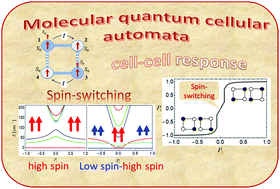 Exploration of the double exchange in quantum cellular automata: proposal for a new class of cellsChemical Communications, 2020
Exploration of the double exchange in quantum cellular automata: proposal for a new class of cellsChemical Communications, 2020In this communication we propose to considerably extend the class of systems suitable as cells for quantum cellular automata by including magnetic quantum dots and molecular mixed valence dimers exhibiting double exchange. As distinguished from the previous works we propose to use not only charges as the information carriers but also spin degrees of freedom. In this context we focus on the two key points: (1) properties of the magnetic cell as reservoir for charges carrying binary information, and (2) identification of conditions under which spin degrees of freedom can be employed.
@article{palii2020exploration, title = {Exploration of the double exchange in quantum cellular automata: proposal for a new class of cells}, author = {Palii, Andrew and Clemente-Juan, Juan Modesto and Rybakov, Andrey and Aldoshin, Sergey and Tsukerblat, Boris}, journal = {Chemical Communications}, volume = {56}, number = {73}, pages = {10682--10685}, year = {2020}, publisher = {Royal Society of Chemistry}, doi = {10.1039/D0CC04135A}, url = {https://pubs.rsc.org/en/content/articlelanding/2020/CC/D0CC04135A}, } -
 Mixed-valence magnetic molecular cell for quantum cellular automata: Prospects of designing multifunctional devices through exploration of double exchangeAndrew Palii, Juan Modesto Clemente-Juan, Sergey Aldoshin, Denis Korchagin, Andrey Rybakov, Shmuel Zilberg, and Boris TsukerblatThe Journal of Physical Chemistry C, 2020
Mixed-valence magnetic molecular cell for quantum cellular automata: Prospects of designing multifunctional devices through exploration of double exchangeAndrew Palii, Juan Modesto Clemente-Juan, Sergey Aldoshin, Denis Korchagin, Andrey Rybakov, Shmuel Zilberg, and Boris TsukerblatThe Journal of Physical Chemistry C, 2020In this article, we propose to use multielectron square-planar mixed-valence (MV) molecules as molecular cells for quantum cellular automata (QCA) devices. As distinguished from previous proposals in this area, in multielectron cells, the electronic pair encoding binary information is shared among localized spins (“spin cores”). Hopefully, this will allow exploring not only charge degrees of freedom encoding binary information in the antipodal electronic distributions but also spin degrees of freedom through the magnetic interactions such as double exchange and Heisenberg-Dirac-Van Vleck (HDVV) exchange. To develop the proposed route, the square-planar tetrameric cells for QCA have been theoretically modeled. The considered cells comprise a pair of excess electrons shared among four spin cores and hence they exhibit double exchange and HDVV exchange. Such cells can be based either on the square-planar mixed-valence molecular clusters or on the similar square arrays of multielectron quantum dots. The detailed case study of the cell representing the transition-metal tetramer of the type of d2-d2-d1-d1 shows that depending on the relative strength of the second-order double exchange and HDVV exchange, the isolated cell has either ground localized spin-triplet or one of the two delocalized spin-singlets, exhibiting different extents of electron delocalization. Due to different sensitivities of these states to the quadrupole electrostatic field induced by the polarized neighboring driver cell, the latter is shown to be able to produce switching between different ground states (including spin-switching between spin-singlet and spin-triplet), which leads to the nonmonotonic behavior of the cell-cell response function. This opens new perspectives for the designing of multifunctional devices combining the QCA functionality with spin-switching function.
@article{palii2020mixed, title = {Mixed-valence magnetic molecular cell for quantum cellular automata: Prospects of designing multifunctional devices through exploration of double exchange}, author = {Palii, Andrew and Clemente-Juan, Juan Modesto and Aldoshin, Sergey and Korchagin, Denis and Rybakov, Andrey and Zilberg, Shmuel and Tsukerblat, Boris}, journal = {The Journal of Physical Chemistry C}, volume = {124}, number = {46}, pages = {25602--25614}, year = {2020}, publisher = {ACS Publications}, doi = {10.1021/acs.jpcc.0c08186}, url = {https://pubs.acs.org/doi/full/10.1021/acs.jpcc.0c08186}, }
2019
-
 Semiclassical versus quantum-mechanical vibronic approach in the analysis of the functional characteristics of molecular quantum cellular automataAndrew Palii, Andrey Rybakov, Sergey Aldoshin, and Boris TsukerblatPhysical Chemistry Chemical Physics, 2019
Semiclassical versus quantum-mechanical vibronic approach in the analysis of the functional characteristics of molecular quantum cellular automataAndrew Palii, Andrey Rybakov, Sergey Aldoshin, and Boris TsukerblatPhysical Chemistry Chemical Physics, 2019In the context of the decisive role that vibronic interactions play in the functioning of molecular quantum cellular automata, in this article we give a comparative analysis of the two alternative vibronic approaches to the evaluation of the key functional characteristics of molecular cells. Semiclassical Born-Oppenheimer approximation and quantum mechanical evaluations of the vibronic energy pattern, electronic density distributions and cell-cell response function are performed for two-electron square-planar mixed valence molecular cells subjected to the action of a molecular driver. Special emphasis is put on the description of the cell-cell response function, which describes strong non-linearity as a prerequisite for the effective action of quantum cellular automata. Comparison of results obtained within the semiclassical and quantum-mechanical approaches has revealed a drastic difference between the shapes of the cell-cell response functions evaluated within these two approaches in the case of moderate vibronic coupling when the energy levels of the square cell interacting with a weakly polarized driver undergo large tunneling splitting in shallow adiabatic potential minima. In contrast, in the limits of strong vibronic coupling (a double-well adiabatic potential with deep minima) and weak vibronic coupling (a single well adiabatic potential) the adiabatic approximation is shown to describe the cell-cell response function with rather good accuracy.
@article{palii2019semiclassical, title = {Semiclassical versus quantum-mechanical vibronic approach in the analysis of the functional characteristics of molecular quantum cellular automata}, author = {Palii, Andrew and Rybakov, Andrey and Aldoshin, Sergey and Tsukerblat, Boris}, journal = {Physical Chemistry Chemical Physics}, volume = {21}, number = {30}, pages = {16751--16761}, year = {2019}, publisher = {Royal Society of Chemistry}, doi = {10.1039/C9CP02516B}, url = {https://pubs.rsc.org/en/content/articlelanding/2019/CP/C9CP02516B}, } -
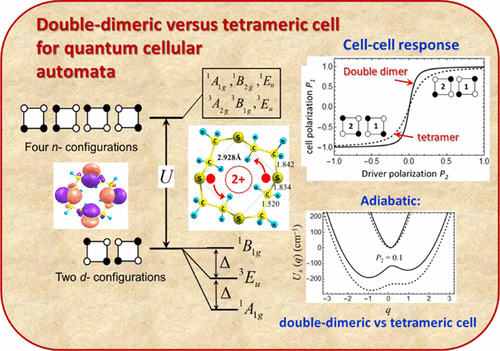 Double-dimeric versus tetrameric cells for quantum cellular automata: A semiempirical approach to evaluation of cell–cell responses combined with quantum-chemical modeling of molecular structuresThe Journal of Physical Chemistry C, 2019
Double-dimeric versus tetrameric cells for quantum cellular automata: A semiempirical approach to evaluation of cell–cell responses combined with quantum-chemical modeling of molecular structuresThe Journal of Physical Chemistry C, 2019Quantum dot cellular automata is a computing paradigm based on transistor-free logic, which in turn relies on the idea of encoding binary information in bistable charge configurations of quantum dots and process information via Coulomb interactions. In the context of molecular implementation of quantum dot cellular automata, we have compared the properties of two possible kinds of molecular square cells, namely, cells tailored from two one-electron mixed valence dimers (double-dimeric cells) and a two-electron mixed valence tetramer. The physical model (based on the Hubbard-type Hamiltonian) of the cells involves the Coulomb interelectronic interaction, electron transfer, and vibronic coupling. We have demonstrated that the difference in the transfer pathways in the two types of cells gives rise to a considerable difference in their functional characteristics. Thus, the double-dimeric cell exhibits a more abrupt nonlinear cell-cell response, which is a prerequisite for the efficient functioning of quantum cellular automata. The difference in the cell-cell responses for the two kinds of cells is shown to be smaller for a weak electron transfer and/or strong vibronic coupling when the mobility of the electronic pair is strongly constrained. The dimeric and tetrameric systems, 1,4-dithia-hexane and crown ether 1,4,7,10-tetrathiacyclododecane, were selected as the molecular systems for the implementation of the proposed Hubbard-type analysis. This choice is prompted by the positive charge localization on the S-atoms, which are not connected covalently. We have performed the quantum-chemical calculations of the 1,4-dithia-compound with two S-atoms connected by a saturated carbon bridge CH2CH2 (proposed as a dimeric subunit) and the corresponding tetrameric structures of the crown ethers 1,4,7,10-tetrathiacyclododecane: parent neutral molecule, cation, and dication. The quantum-chemical estimations allowed us to quantitatively unveil the key parameters of the dimeric and tetrameric systems and to conclude that the proposed compounds can serve as cells with predominantly antipodal charge separation, which are potentially able to encode binary information.
@article{palii2019double, title = {Double-dimeric versus tetrameric cells for quantum cellular automata: A semiempirical approach to evaluation of cell--cell responses combined with quantum-chemical modeling of molecular structures}, author = {Palii, Andrew and Zilberg, Shmuel and Rybakov, Andrey and Tsukerblat, Boris}, journal = {The Journal of Physical Chemistry C}, volume = {123}, number = {36}, pages = {22614--22623}, year = {2019}, publisher = {ACS Publications}, doi = {10.1021/acs.jpcc.9b05942}, url = {https://pubs.acs.org/doi/full/10.1021/acs.jpcc.9b05942}, }
